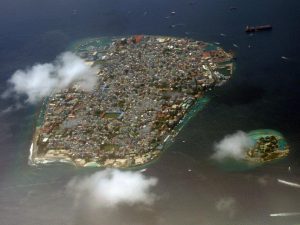Meeting in the Marshall Islands, where the highest point is only three metres above sea level, the leaders of 13 Pacific island nations, backed by Australia and New Zealand, last month called on the economic superpowers that emit most carbon to save them from becoming the world’s first climate change refugees.
The 44th meeting of the Pacific Islands Forum, held in the capital Majuro, adopted a declaration that proclaims the region’s commitment to demonstrating “climate leadership” and asks countries around the world to join in by listing specific pledges to reduce carbon emissions.
The Majuro Declaration also calls for urgent action from the world’s biggest emitters — China, the European Union, India, Japan and the United States — at the UN climate talks in Warsaw this week to speed up moves to slow down global warming.
“Waiting for a new global agreement in 2015 will not be enough. Accelerating climate action now, and well before 2020, is critical,” said Pacific Islands Forum chair and Marshall Islands President Christopher Loeak.
His desperate appeal for urgent action was hardly surprising – even coming as it did before Typhoon Haiyan hit the Philippines two weeks ago. A number of Pacific islands are living close to the edge, literally on the front-line of climate change and its after-effects, with more frequent and severe natural disasters such as cyclones, floods, tidal surges, droughts and coral reef destruction.
In May, drought hit the Marshall Islands’ northern atolls for the first time in recent memory, leaving many residents without enough food and water. Then, in July, storm surges breached the sea wall that protects Majuro and flooded the capital.
Two of Kiribati’s islands are already submerged. In early 2005, other islands were flooded by a high spring tide that washed away farmland, swept salt water into wells and inundated homes and a hospital.
Saving island nations
The average elevation of most of the Pacific Islands Forum nations is about two metres above sea level. For many of the smallest and most vulnerable of these nations, the first line of defence is to mitigate the effects of climate change.
Their leaders want to galvanise a new wave of climate action beyond words and pledges. They demand concrete actions and commitments from everyone.
They cite the recent World Bank report, ‘Turn Down the Heat’, which warned that, without decisive climate action, even a best-case scenario could see the world warm by four degrees Celsius by the end of the century.
If temperatures increase by this amount, sea levels could rise by 50 centimetres to a metre, resulting in the loss of fresh water in many islands. Coral reef systems could be wiped out and low-lying atolls would be submerged.
But if nations act quickly enough to minimise carbon emissions, the world may still avoid the worst effects of climate change. Switching to green energy such as solar, wind, hydroelectric and geothermal could limit sea level rise. However, doing so will not guarantee that global warming will be reversed. So the fallback for these threatened Pacific island nations might just be to adapt.
Huge investments are needed to help vulnerable Pacific nations adapt to the effects of global warming and improve their resilience. The World Bank provided more than US$8 billion in 2012 to the Pacific nations to help mitigate global temperature rises.
In Samoa, the bank is working to ‘climate proof’ transport infrastructure and help the UN improve the resilience of coastal communities. In Vanuatu, the bank and the European Union are educating farmers about the introduction of climate-resilient livestock and crops and the implementation of disaster risk management programmes. A tsunami-warning system has been set up in Port Vila, the nation’s capital, and in the city of Luganville, and hazard response systems are being improved.
Australia and New Zealand have helped Kiribati set up a project that has increased water supply by 20 per cent in the capital, South Tarawa. They are also building sea walls and have planted more than 37,000 mangroves to protect coastlines.
“The children of the Pacific deserve our best efforts so they can grow up to live on the same soil as their parents and grandparents,” said Axel van Trotsenburg, the World Bank’s vice-president for East Asia and the Pacific.
Last line of defence
But if mitigation of global warming and adaptation to its cruel after-effects fail, the last line of defence is evacuation. Kiribati has prepared for this.
The website SciDev.Net reported last year that the Kiribati cabinet, fearing that climate change could wipe out their archipelago, had approved a plan to buy nearly 6,000 acres on Fiji’s main island, Viti Levu, where some or all of Kiribati’s population of 103,000 could move to if necessary.
Other Pacific island nations’ leaders are still in various stages of denial. No one wants to consider this ultimate solution now.
Tony de Brum, the minister-in-assistance to the president of the Marshall Islands, said “if we do have to displace the population, God forbid, then we will have to start thinking about who’s going to be responsible for what happens to our nation, what happens to our sovereignty and what happens to our culture and tradition.”
Heartbreaking words indeed. But, in time, the tiny island nations may have to accept the inevitable and move to higher ground. There is only so much that science and politics can do. Just as Canute, the Danish king who ruled England in the eleventh century, could not command the sea to stop coming in, they too have limited control over climate change and efforts to prevent the Pacific Ocean from rising.
This article was first published by SciDev.Net





